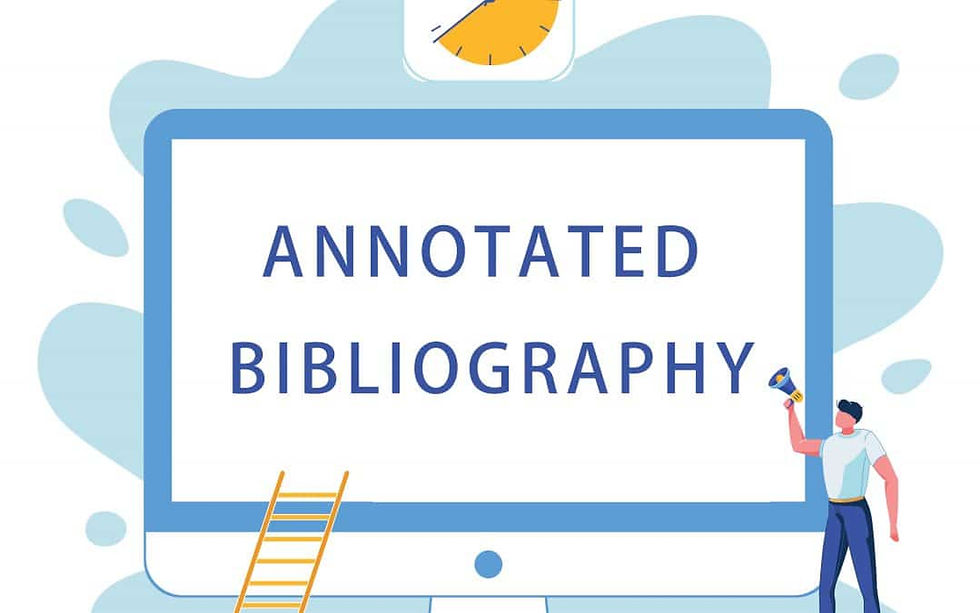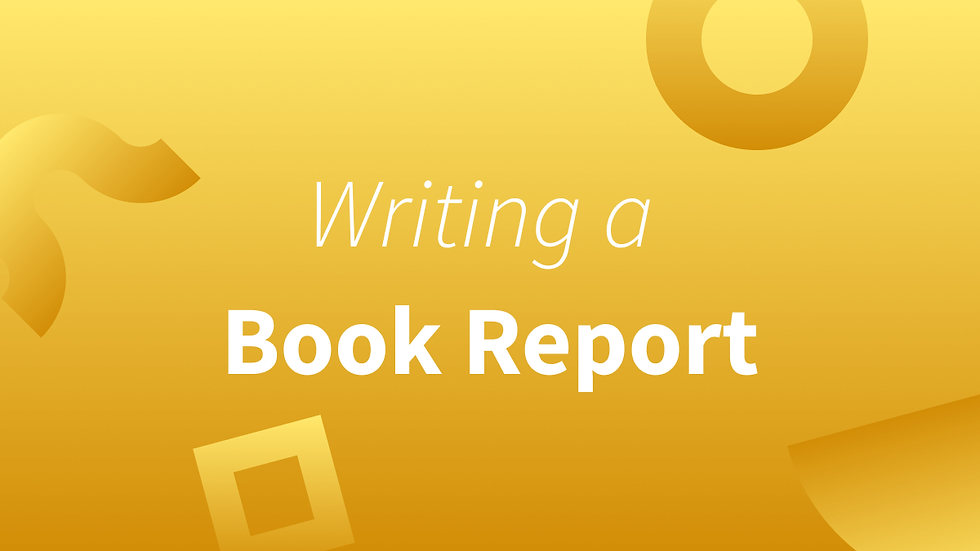ANNOTATED BIBLIOGRAPHY: WHAT IS IT?
- Wayne Kisanyanya
- Jan 5, 2024
- 5 min read
An annotated bibliography compiles a significant portion of the prior research published on a certain academic topic, making it very comparable to a literature review. Annotated bibliographies are not narrative in nature, in contrast to literary reviews. Instead, compiling a list of previously published references on the subject and providing notes for each one is the process of constructing an annotated bibliography. These annotations, which are usually between 150 and 400 words long, contain additional functionalities that are covered in more detail below in addition to summarizing the relevant source.
Annotated bibliography writing can be done on its own or as a component of a longer assignment like a thesis or dissertation. The general guidelines will be the same regardless of the purpose for which you are producing an annotated bibliography. To locate publications on your subject, use Google Scholar or your preferred academic database. After that, you should take thorough notes and organize these articles into groups according to themes or chronological order. After completing this, you should summarize each of these sources and arrange them in a list for your annotated bibliography.
Generally speaking, you want to give priority to materials that have been released in the recent five years when creating an annotated bibliography. This method of writing an annotated bibliography is better because it entails writing about the most recent developments in the field related to your subject. Having said that, if a source is a classic work that has never been duplicated or if no one has worked on it in the last five years, you could want to include it in an annotated bibliography. When you write an annotated bibliography, it indicates that you have studied the subject matter thoroughly. To create a fantastic annotated bibliography, combine a significant amount of recent study with some classic, earlier studies. If you are writing about Freudian psychoanalysis, for instance, you should cite Freud even though his source is over a century old, but you should also cite the most recent research on the topic.

In the end, creating an annotated bibliography entails more than just identifying the sources you will use; it also entails assessing each one's quality and explaining to the reader how your research paper, thesis, or dissertation will use it. Since listing the sources that are pertinent to delving into a certain issue is the main goal of producing an annotated bibliography, it is simple to convert an annotated bibliography into a literature review after it has been finished and evaluated. Because an annotated bibliography can be a valuable tool for future research papers and essays, it is usually not a waste of time to write one. Therefore, when creating one, keep this possible usage in mind.
DIRECTIONS FOR WRITING AN ANNOTATED BIOGRAPHY
Selecting a topic is the first stage in creating an annotated bibliography. Occasionally, you might be given the topic or it might have something to do with writing a thesis or dissertation. In other situations, you can be creating an annotated bibliography, in which case you will be able to select the subject of your essay. Selecting a topic with a large body of published research is crucial when preparing an annotated bibliography, as it facilitates the process of locating materials for your literature review. For your annotated bibliography, search a wide range of publications on your subject using online databases such as Google Scholar, Magenta, and JSTOR. Read the abstracts of these sources before reading the full texts. This will assist you in deciding whether or not they are pertinent to your annotated bibliography writing.
After deciding on a topic and identifying research themes, you should start selecting the materials you'll need to write your annotated bibliography. The next step is to read through these various sources and make notes. If you need to rapidly prepare an annotated bibliography, skimming the abstract might be useful, but reading the complete source is recommended. This is particularly true if you intend to use it in your dissertation, thesis, or research article. Make notes on the key ideas, the sources' shortcomings, and how you believe they will help you with your research paper, thesis, or dissertation.
Last but not least, creating an annotated bibliography involves much more than just listing all of the sources you will utilize. Each entry in your annotated bibliography should contain four components because producing an annotated bibliography is usually done before writing a research paper, thesis, or dissertation. First, create an annotated bibliography with an article summary included for each entry. Second, enumerate and go over the writers' qualifications. Third, explain to the reader how the entry's source can help you with your research paper, thesis, or dissertation writing. Lastly, list any flaws you discovered in the source. Your annotation is finished after you follow these four stages, which you can then include when creating an annotated bibliography.
AN ANNOTATED BIBLIOGRAPHY'S FORMAT
You will probably be requested to format your annotated bibliography in one of the following styles: Turabian, MLA, APA, Chicago, or Harvard. It is crucial that you locate an annotated bibliography template for the style that has been assigned to you or a style guide for the required citation style, depending on which style has been assigned to you. Making sure that all of your sources are properly cited throughout your annotated bibliography will help you avoid losing points. Additionally, it's critical to ensure that you properly credit all of your sources in order to prevent plagiarism accusations. Make sure that every citation in your annotated bibliography is accurate before submitting it.
It's time to go over your annotations after you've formatted and referenced your annotated bibliography using the style guide you were requested to use. A synopsis of the article, an outline of the author's qualifications, an explanation of how the source can help you with your research paper, thesis, or dissertation, and a critique of the article's shortcomings should all be included in your annotations. You can't produce an annotated bibliography and receive an A+ unless all of these components are presented.
AN ANNOTATED BIBLIOGRAPHY AND A LITERATURE REVIEW: WHAT'S THE DIFFERENCE?
The format that an annotated bibliography adopts is the primary distinction between it and a literature review. Annotated bibliographies are lists of sources with annotations, whereas producing a literature review entails summarizing materials and putting them side by side in a written document. Although the notes you make in an annotated bibliography may resemble the paragraphs you would write in a literature review, an annotated bibliography does not require you to integrate or juxtapose your sources in relation to one another. Instead, all you have to do to write an annotated bibliography is put your sources and remarks in a list.



Comments